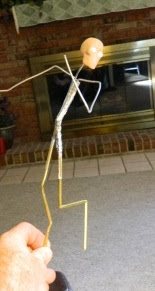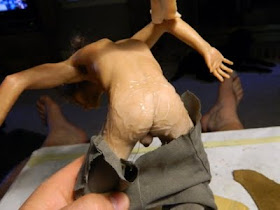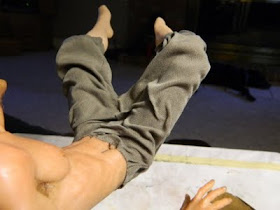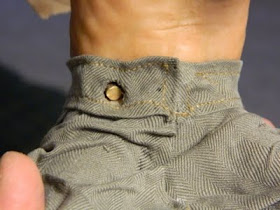These figures will be independent of each other so there is no special armature needed. I photographed these as a step by step so you can review the armature without going all the way back to another, older post.
The armature consists of three 14 gauge wires. The first of which is about 20" long and is bent at the half-way point for the legs. The second wire is about 18" long and bent at the middle as well. This is the arm wire. This figure will be about 12" tall when complete.
A 5/32 brass tube is slide up each leg wire to add rigidity to the sculpture.
45 degree bends are made in the lower armature at the waist. The upper armature is bent at the point where the neck will emerge.
Additional bends are made at the hip joint (not the hip bone) and at the shoulder.
An additional wire is added down the spine. This will support the head. The three parts are wrapped tightly with foil tape.
The wire and tube part of the armature is done. Note that the legs are bent for a digitgrade (animal which walks on its toes: wolf, dog, etc...) animal's joints.
The figure is padded out with foil. We want about 3/8" of clay over the foil as we sculpt so you need to bulk out enough to fill the torso.
Legs get bulked out to the knee joint.
Everything gets covered in tape to keep the oxidation from transferring to the clay.
The finished armature,
The figures are posed together so we can adjust the drama of the moment.
Next we will do a little face work.
Have a great day!
Mark
The armature consists of three 14 gauge wires. The first of which is about 20" long and is bent at the half-way point for the legs. The second wire is about 18" long and bent at the middle as well. This is the arm wire. This figure will be about 12" tall when complete.
A 5/32 brass tube is slide up each leg wire to add rigidity to the sculpture.
45 degree bends are made in the lower armature at the waist. The upper armature is bent at the point where the neck will emerge.
Additional bends are made at the hip joint (not the hip bone) and at the shoulder.
An additional wire is added down the spine. This will support the head. The three parts are wrapped tightly with foil tape.
The wire and tube part of the armature is done. Note that the legs are bent for a digitgrade (animal which walks on its toes: wolf, dog, etc...) animal's joints.
The figure is padded out with foil. We want about 3/8" of clay over the foil as we sculpt so you need to bulk out enough to fill the torso.
Legs get bulked out to the knee joint.
Everything gets covered in tape to keep the oxidation from transferring to the clay.
The finished armature,
The figures are posed together so we can adjust the drama of the moment.
Next we will do a little face work.
Have a great day!
Mark


























































